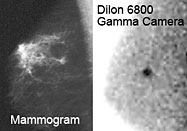- Number 287 |
- May 25, 2009
Lifesaving tech transfer

The mammogram of a patient's
right breast shows dense tissue
that was considered normal but
was being monitored in yearly
mammograms. The BSGI image
taken with the Dilon 6800 Gamma
Camera reveals the cancer missed
by the mammogram.
Breast cancer strikes more women in the U.S. than any other cancer. The first line of defense is to spot it early with mammography, but mammograms can be inconclusive. Technology developed by the Radiation Detector & Imaging Group at DOE's Jefferson Lab and licensed to a local startup company is now being used worldwide to complement mammograms. Based on gamma-imaging technology, BSGI is a non-invasive breast imaging procedure that captures the cellular function of breast tissue. Used with mammography, breast-specific gamma imaging helps to resolve difficult-to-interpret cases. The group's work was recently recognized with an award for “excellence in technology transfer” by the Federal Laboratory Consortium for Technology Transfer.
[Kandice Carter, 757.269.7263,
kcarter@jlab.org]
